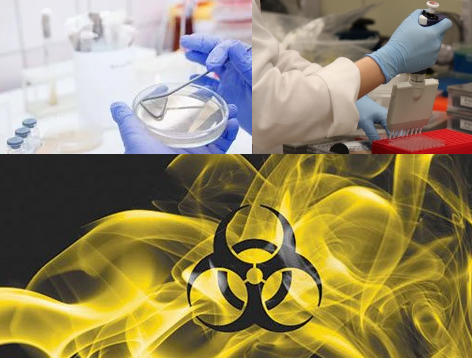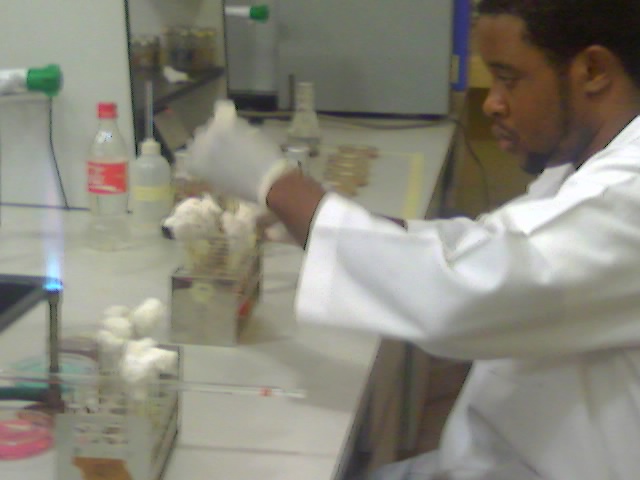The great majority of microorganisms are beneficial to man, plants, animals and the environment. These microorganisms that are non-pathogenic in nature have been applied since time immemorial to produce goods and services and products that are of immense benefit to man, animals, plants and the environment. These vast numbers of non-pathogenic microorganisms are harmless to humans and animals.
On the other hand, pathogenic microorganisms (which cause disease in humans, animals and plants) represent only a small part of the total microorganisms in the world. Pathogenic microorganisms have received more attention than the harmless (non-pathogenic) microbes because they represent a threat to human and animal health and even the health of the environment and plants as well. The disease they cause can bring the economy of a nation to a halt if they are not controlled.
Microorganisms are classified into four (4) groups based on the level of risk that they pose to the user or researcher, the environment and the laboratory handing them. These groups are relative hazards of infective microorganisms by risk groups according to the World Health Organization (WHO).
The WHO Risk Groups of microorganisms are:
- Risk Group 1
- Risk Group 2
- Risk Group 3
- Risk Group 4
Risk Group 1 Microorganisms
Risk Group 1 microorganisms (also known as Pathogen Risk Group 1)are microbes or pathogens with no or low individual and community risk. Microorganisms in this group (Risk Group 1) do not pose any danger to the individual working with it in the laboratory. And if they do, the risk is usually low and not significant. Risk Group 1 microorganisms also do not pose any risk to the community, and if they do, the risk is usually low and insignificant.
Generally, the Risk Group 1 microorganisms are unlikely to cause human or animal disease. They are not known to cause infection or disease in human or animal population. Risk Group 1 microorganisms pose the lowest risk to individuals and the environment. A Pathogen Risk Group 1 microorganism is a microorganism that is unlikely to cause human or animal disease. They are said to be apathogenic because they cause no known disease to humans or animals.
Examples of Risk Group 1 Microorganisms include adeno-associated virus (AAV), Saccharomyces cerevisiae, Lactobacillus acidophilus, Escherichia coli K-12, Laccaria bicolor, Agrobacterium radiobacter, Aspergiullus niger, and Bacillus thuringiensis.
Risk Group 2 Microorganisms
Risk Group 2 microorganisms (also known as Pathogen Risk Group 2) are microorganisms that pose moderate individual risk to personnel in the laboratory and low community risk. Pathogens in this category are known to cause human or animal disease but are unlikely to be a serious hazard to laboratory workers, the community, livestock or the environment.
Laboratory exposures to Pathogen Risk Group 2 microorganisms may cause serious infections, but effective treatment and preventive measures are available. The risk of spread of infections caused by Pathogen Risk Group 2 microbes is usually limited. Microorganisms classified as Risk Group 2 are known to cause human disease and can be hazardous to workers in the laboratory. Microorganisms in this category are unlikely to spread to the community.
There is usually effective prophylaxis or treatment for the management and effective control of diseases or infections caused by Risk Group 2 microorganisms. Generally Risk Group 2 microbes cause disease in human or animals but the disease or infection they cause is not a serious one.
Examples of Risk Group 2 Microorganisms include Rotavirus, Salmonella, Shigella, Ross River virus, Campylobacter, Influenza, Candida albicans, Coccidioides immitis, Streptococcus.
Risk Group 3 Microorganisms
Risk Group 3 Microorganisms (also known as Pathogen Risk Group 3 Microbes) are microorganisms that pose a high individual risk and low community risk. Microorganisms in this category can cause serious disease or infection in humans or animals but they do not ordinarily spread from one infected individual to another.
There is usually effective treatment and preventive measures for infections or diseases caused by microorganisms in the Risk Group 3 category of microbes. Risk Group 3 pathogens are associated with serious or lethal human or animal diseases. They can cause life-threatening diseases in humans and animal populations. Microorganisms in this category pose serious threat to the health of personnel working with them in the laboratory.
Risk Group 3 Microorganisms can cause severe human disease and present a serious hazard to the workers in the laboratory. They present a risk of spreading to the community but there is usually effective prophylaxis or treatment for their management and control.
Examples of Pathogen Risk Group 3 agents or pathogens include influenza viruses A H1N1 (1918), H2N2 (57-68) and H5N1 (bird flu), Yersinia pestis, Francisella tularensis, Prions, Hantavirus.
Risk Group 4 Microorganisms
Risk Group 4 Microorganisms (also known as Pathogen Risk Group 4 Microbes) are microorganisms, agents or pathogens that pose a high risk to individuals and communities. Pathogens classified as Risk group 4 organisms usually cause serious human or animal diseases or infections that can be readily transmitted from one individual to another, either directly or indirectly.
For infections or diseases caused by Risk Group 4 Pathogens, there is usually no available effective treatment and preventive measures. Microorganisms in Risk Group 4 produce very serious disease in humans and animals. There are no bacteria, fungi or parasites in the Risk Group 4 pathogens. Only viruses are usually found in Risk Group 4.
Risk Group 4 Microorganisms or agents can cause serious or severe human disease. They pose a serious hazard to workers in the laboratory. Risk Group 4 microorganisms may represent a high risk of spreading to the community. For diseases or infections caused by Risk Group 1 microbes, there is usually no effective prophylaxis or treatment available for their immediate control, management or treatment.
Examples of Risk Group 4 Pathogens include Lassa fever virus, Ebola virus, SARS-CoV-2, and Smallpox virus.
Description of biosafety levels based on the type of agents
Microbiology laboratories inclusive of other research and hospital laboratory are designed as basic – Biosafety Level 1, basic – Biosafety Level 2, containment – Biosafety Level 3, and maximum containment – Biosafety Level 4. These biosafety designations are usually based on a composite of the design features, construction, containment facilities, equipment, practices and operational procedures required for working with pathogens or agents from the various risk groups described above.
Factors to take into account when constructing a laboratory or working with a microorganism
Countries and institutions should draw up an institutional or national classification of microorganisms by risk group while taking into account the following criterion:
- Pathogenicity of the microorganism.
- Mode of transmission and host range of the microbe. These may be influenced by existing levels of immunity in the local population, density and movement of the host population, presence of appropriate vectors, and standards of environmental hygiene.
- Local availability of effective preventive measures. These may include prophylaxis by immunization or administration of antisera (passive immunization), sanitary measures such as food and water hygiene, control of animal reservoirs or arthropod vectors.
- Local availability of effective treatment. This may include passive immunization, postexposure vaccination, and use of antimicrobial agents, antivirals, and chemotherapeutic agents. It should also take into consideration the possibility of the emergence of drug-resistant strains.
The assignment of an agent or pathogen to a biosafety level for laboratory work must be based on a risk assessment (Table 1). Such an assessment will take the risk group as well as other factors into consideration in establishing the appropriate biosafety level. For example, an agent that is assigned to Risk Group 2 may generally require Biosafety Level 2 facilities, equipment, practices and procedures for safe conduct of the experiment or work or study or research (Table 2).
Nonetheless, if particular experiments require the generation of high-concentration aerosols, then Biosafety Level 3 may be more appropriate to provide the necessary degree of safety, since Biosafety Level 3 ensures superior containment of aerosols in the laboratory workplace than Biosafety level 2. The biosafety level assigned for the specific work to be done is therefore driven by professional judgment based on a risk assessment, rather than by automatic assignment of a laboratory biosafety level according to the particular risk group designation of the pathogenic agent to be used.
The assignment of a biosafety level takes into consideration the following factors:
- The pathogenic agent (microorganism) used
- The facilities available,
- The equipment practices, and
- The procedures required to conduct work safely in the laboratory.
Table 1. Relation of risk groups to biosafety levels, practices and equipment
| Risk group | Biosafety level | Laboratory type | Laboratory practices | Safety equipment |
| 1 | Basic-Biosafety Level 1 | Basic teaching, research | Good microbiological technique (GMT) | None, open bench work |
| 2 | Basic-Biosafety Level 2 | Primary health services, diagnostic services, research | GMT plus protective clothing, biohazard sign | Open bench plus biological safety cabinet (BSC) and/or other primary devices for all activities |
| 3 | Containment-Biosafety Level 3 | Special diagnostic services, research | As level 2 plus special clothing, controlled access, directional airflow | BSC and/or other primary devices for all activities |
| 4 | Maximum containment-Biosafety Level 4 | Dangerous pathogen units | As level 3 plus airlock entry, shower exit, special waste disposal | Class III BSC, or positive pressure suits in conjunction with class II BSCs, double ended autoclave (through the wall), filtered air |
Table 2. Summary of biosafety level (BSL) requirement
| BSL | BSL | BSL | BSL | |
| 1 | 2 | 3 | 4 | |
| Isolation of laboratory | No | No | Yes | Yes |
| Room sealable for decontamination | No | No | Yes | Yes |
| Ventilation: | ||||
| – Inward airflow – Controlled ventilating system – HEPA-filtered air exhaust | No No No | Desirable Desirable No | Yes Yes Yes/No | Yes Yes yes |
| Double-door entry | No | No | Yes | Yes |
| Airlock | No | No | No | Yes |
| Airlock with shower | No | No | No | Yes |
| Anteroom | No | No | Yes | – |
| Anteroom with shower | No | No | Yes/No | No |
| Effluent treatment | No | No | Yes/No | Yes |
| Autoclave: | ||||
| – on site | No | Desirable | Yes | Yes |
| – in laboratory room | No | No | Desirable | Yes |
| – double-ended | No | No | Desirable | Yes |
| Biological safety cabinets | No | Desirable | Yes | Yes |
| Personnel safety monitoring capability | No | No | Desirable | Yes |
Source
www.who.int
Discover more from #1 Microbiology Resource Hub
Subscribe to get the latest posts to your email.



